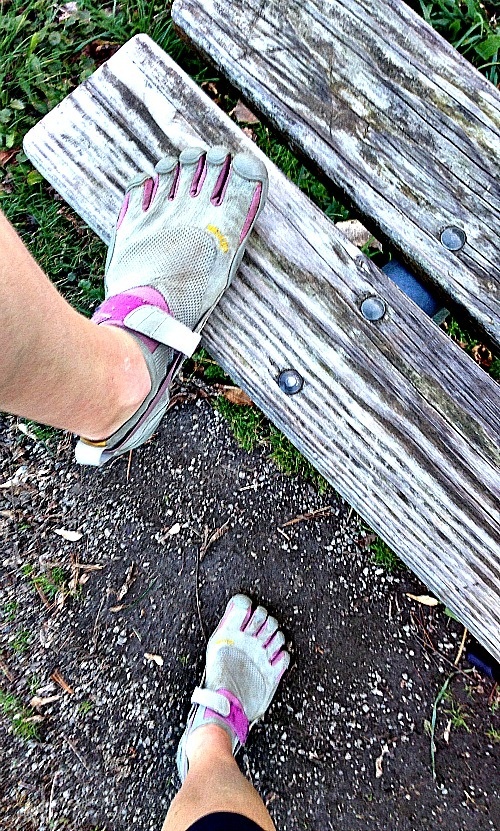At a certain point, you must wear less on your feet to strengthen them and to polish your forefoot running form. The longer you wear the Vibram barefoot shoes, the better your feet will feel.
These shoes are a game-changer in that they can do things that regular running shoes can’t do. For instance, the Vibram FiveFingers improve the communication speed between the nerves in your feet and the nerves in your ankle, knee and hip joints. Regular running shoes do not have this capability because the cushioned materials is too thick to activate and stimulate the nerves in the feet, which is what is required to build more foot strength.

Why Vibram Barefoot Shoes Work
Many experts agree that the Vibram FiveFingers are much less threatening and far more stability-friendly than the standard running shoe.
A new study found that footwear determines stability because the degree of balance control varied with footwear cushioning. A study by Smith et al. (2015) reported participants in the Vibram FiveFingers automatically had better balance control compared to participants in the standard running shoe.
The researchers also found that static balance in the Vibram FiveFingers was similar to barefoot. This finding is important because proprioception is the only sure way to improve balance, and the only way to boost proprioception is by being barefoot or in footwear that closely approximates barefoot.
Fittingly, Kelly et al. (2012) found that barefoot activity increased activation of the intrinsic foot musculature in one leg stance compared to double leg stance.
Boosts Nerve Signaling
The human foot is densely packed with proprioceptors and proprioception mediates balance, strength and reaction speed of the ankle, hip and knee joints. However, cushioned footwear may affect proprioceptor density in a way that compromises the brain’s spatiotemporal-processing capacity, resulting in impaired balance control.
To provide a satisfying explanation for this, Hosada et al. (1997) purported that thicker soles may inhibit or slow neural impulses traveling from the plantar surface to the ankle joints as well as from muscle spindles in the ankle joint muscles which would result in reduced strength and reaction speed.
Comparatively, barefoot is associated with more rapidly conducting nerves in the feet, suggesting that information travels faster under barefoot or barefoot-like shod conditions than in the standard running shoe. This, of course, is due to the demonstrably greater proprioception in barefoot-like conditions.
The Take Home Message
Good balance control corresponds to heightened proprioception and it is obvious that barefoot-like conditions is the direct precursor to this heightened proprioception. Reduced proprioception explains why the average habitual shod jogger has demonstrably faulty balance compared to habitual barefoot runners.
Moreover, timing corresponds to enhanced proprioception –the longer you are barefoot, or in barefoot like shoes, such as the Vibram FiveFingers, the better your balance will be. In this view, injuries related to poor balance are caused by the standard running shoe simply because a runner cannot control his or her balance which generally mirrors findings from related studies: joggers who do not go minimal or barefoot get injured more than those who do.
More From Run Forefoot:
- Vivobarefoot Forefoot Running Shoe Review
- Getting Old, Heel Pad Health and Heel Strike Running
- Rates of Success for Injury Prevention in Heel Strikers and Forefoot Strikers
- Forefoot Running Less Damaging on Footwear
- Why Heel Strikers Get Anterior Shin Pain
- Best Shoes for Forefoot Running
Also, don’t forget to visit the Run Forefoot Facebook Page for more tips on forefoot striking, barefoot running and running shoes. It is a great place to ask questions about how to run properly. I’ll be happy to answer them for ya!
References:
Hosada M, Yoshimura O, Takayanagi K, et al. The Effect of Various Footwear Types and Materials, and of Fixing of the Ankles by Footwear, on Upright Posture Control. J Phys Ther Sci. 1997; 9 (1):47-51.
Kelly LA, Kuitunen S, Racinais S, Cresswell AG. Recruitment of the plantar intrinsic foot muscles with increasing postural demand. Clin Biomech. 2012; 27: 46-51.
Smith et al. Effect of wearing athletic footwear, five-toed shoes, and standing barefoot on balance performance in young adults. Int J Sports Phys Ther, 2015;10(1):69-74.
Bretta Riches
BSc Neurobiology; MSc Biomechanics candidate, ultra minimalist runner & founder of RunForefoot. I was a heel striker, always injured. I was inspired by the great Tirunesh Dibaba to try forefoot running. Now, I'm injury free. This is why I launched Run Forefoot, to advocate the health & performance benefits of forefoot running and to raise awareness on the dangers of heel striking, because the world needs to know.
Latest posts by Bretta Riches (see all)
- Can You Run In Barefoot Shoes? Yes, But DON’T Heel Strike! - 21/07/2024
- Why Cushioned Running Shoes Are Really Bad for Your Feet - 19/07/2024
- Do Cushioned Running Shoes Cause Injuries? - 17/07/2024

Leave a Reply